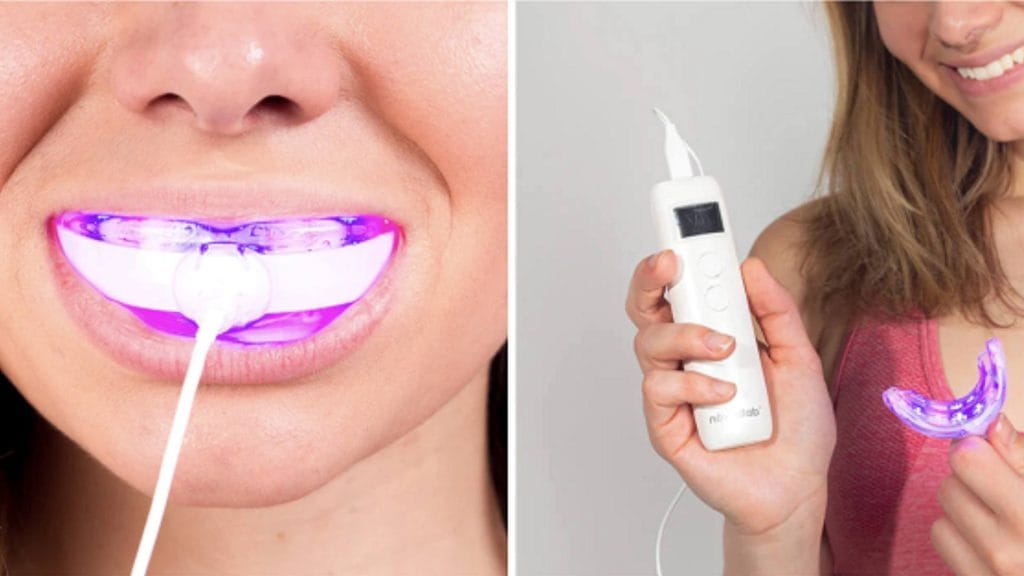Red Light Therapy for Oral Health: Treatment, Benefits, Risks
We include links to products we think are useful for our readers. If you click and buy a product through one of the affiliate links on this page, we may earn a small commission.

Red light therapy (RLT) is gaining attention not just for its benefits in muscle recovery and reducing inflammation, but also for its effectiveness in maintaining the health of gums and teeth. This form of therapy uses low wavelength red light to improve health in various ways. What might surprise you is how RLT is proving to be a game changer in oral health care.
How can a simple beam of light make a difference in oral health? As we explore red light therapy’s applications, you’ll discover its potential to revolutionize dental treatments, offering a pain-free alternative to conventional methods.
Key Takeaways
Red light therapy can enhance tissue repair, reduce inflammation, and improve blood circulation in oral tissues.
It’s a non-invasive and pain-reducing alternative to traditional dental treatments like scaling and root planing.
The therapy is effective for treating various oral conditions such as gum disease and infections.
While generally safe, it’s important to use red light therapy devices correctly to avoid potential mild side effects.
Red light therapy complements traditional dental treatments, offering holistic benefits and speeding up healing processes.
Benefits of Red Light Therapy for Oral Health

Red light therapy (RLT) is a fascinating development in dental care, with its benefits extending well into various aspects of oral health. This non-invasive treatment option uses low-level wavelengths of red light to promote healing and maintenance in the mouth.
Here’s a detailed look at how red light therapy can be a significant asset in oral healthcare.
Enhanced Tissue Repair and Regeneration
One of the primary benefits of red light therapy is its ability to enhance tissue repair and promote regeneration. The mitochondria in our cells — often referred to as the powerhouse of the cell — respond particularly well to red light. This light stimulates the mitochondria, enhancing their energy production capabilities, which in turn speeds up the cell’s healing process.
This is particularly beneficial for gum tissues that may have been damaged due to surgery or disease. The accelerated cellular regeneration helps in quick recovery, reducing the period patients suffer from post-operative symptoms such as swelling and tenderness.
Reduction in Inflammation and Pain Relief
Inflammation is a common response of the body to injury or infection, which often accompanies many oral health issues, including gum disease and dental procedures. Red light therapy works by reducing the activity of cytokines, which are inflammatory molecules. This reduction in inflammation not only helps in alleviating pain but also aids in preventing further tissue damage.
For instance, patients suffering from conditions like gingivitis or periodontitis can experience significant relief from the discomfort associated with these diseases. Moreover, the therapy’s ability to dampen pain responses makes it an excellent adjunct to more invasive procedures, helping manage pain without the extensive use of medications.
Read also: Red Light Therapy Treatment for Joint Pain
Improvement in Blood Circulation in Oral Tissues
Good circulation is vital for optimal oral health. Enhanced blood flow ensures that adequate oxygen and nutrients are delivered to gum and tooth tissues, which is essential for their health and integrity. Red light therapy increases the formation of new capillaries in the tissues, which improves blood flow.
This not only helps in reducing recovery times following dental surgeries but also promotes healthier gum tissues. Increased circulation can also enhance the effectiveness of other dental treatments by improving the delivery of therapeutic agents to the targeted areas.
Effects on Bacterial Levels in the Mouth
The oral cavity is a complex ecosystem with a vast array of microbial inhabitants. While many of these microbes are harmless or even beneficial, some can cause dental decay and gum disease if their numbers grow too large. Red light therapy has been shown to have a bactericidal effect, which means it can kill bacteria, thereby helping to maintain a healthy balance of oral microbiota.
This reduces the risk of cavities, gingivitis, and other common oral health issues. Furthermore, by lowering the bacterial load, red light therapy can also diminish bad breath, which is often caused by bacteria.
Scientific Insights into Red Light Therapy for Oral Health

The effectiveness of red light therapy in oral health is backed by various scientific studies. These studies suggest that the specific wavelengths of red light used in RLT penetrate tissues to a depth of about 5 to 10 millimeters. This penetration stimulates biological processes that would otherwise slow down due to age, disease, or injury.
One particular survey, one conducted by Novaalab, involved 205 participants to analyze the effects of their red light therapy device, Oral Care Pro. In paper, Novaalab used a cross-tab analysis to provide a clear picture of the therapy’s effectiveness across different user groups.
Key Findings from the Survey
Of the 205 participants, 39 had exclusively used Oral Care Pro for their oral health regimen. The results were particularly positive; 85% of these users reported a significant relief in dental and periodontal pain. This high percentage underscores the effectiveness of the device in managing pain, a primary concern for many dental patients.
Detailed Analysis of Benefits
The study further highlighted that users experienced reduced inflammation and overall improved oral health. These improvements are attributed to the device’s ability to enhance blood circulation, boost cellular metabolism, and decrease inflammatory responses within the oral cavity.
Reduced Inflammation: Consistent with other scientific findings, the reduction in inflammation among the study participants likely contributed significantly to their pain relief. Inflammation is often a key factor in various oral health issues, such as gingivitis and periodontitis, and managing it effectively can lead to better health outcomes.
Improved Overall Oral Health: The survey also indicated an improvement in overall oral health among users, suggesting that Oral Care Pro may help in maintaining a healthy oral environment. This can be particularly beneficial for long-term dental health, potentially reducing the incidence of cavities and other common dental issues.
Implications of the Findings
The findings from Novaalab’s study are crucial for the broader acceptance and understanding of red light therapy in dental care. By demonstrating clear benefits such as pain reduction, decreased inflammation, and improved oral health, Oral Care Pro stands out as a viable non-invasive treatment option that could complement traditional dental therapies.
The insights from this study not only validate the effectiveness of red light therapy but also encourage further research and development in this area. As more dental professionals become aware of and access such technology, it could lead to more widespread adoption in routine dental care practices.
Novaalab Oral Care Pro
Oral Care Pro provides fast relief from dental pain. Enjoy a fresher mouth every day. Use professional-grade light therapy at home.
Risks and Considerations in Treating Dental Pain with Red Light Therapy
When considering red light therapy (RLT) for dental pain, it’s important to be aware of both the potential and the precautions.
Here’s what you need to know:
Possible Mild Side Effects: While red light therapy is generally safe, some users might experience mild discomfort or irritation. These side effects are typically minor and temporary (and we’ve yet to find severe ones).
Proper Use is Crucial: To avoid oral damage, it’s essential to use RLT devices according to the manufacturer’s instructions. Incorrect use can lead to less effective results or potential harm.
Consultation with Healthcare Providers: Before starting any new treatment, especially involving RLT, consulting with a healthcare provider is vital. They can advise whether RLT is appropriate for your dental issues and ensure it doesn’t conflict with other health conditions or treatments.
Comparing Red Light Therapy to Other Oral Health Treatments
Red light therapy (RLT) is becoming a popular alternative and complement to traditional oral health treatments. Here’s how it stacks up:
Comparison with Traditional Dental Treatments: Traditional treatments like scaling and root planing are effective for deep cleaning and treating gum disease. RLT, on the other hand, offers a non-invasive option that promotes healing and reduces inflammation without physical removal of tartar.
Analysis of RLT versus Pharmaceutical Interventions: Unlike pharmaceuticals that often come with systemic side effects, RLT provides a targeted approach with minimal side effects. Pharmaceuticals typically manage symptoms or fight infections, while RLT aids in healing and recovery.
Benefits of Combining RLT with Other Treatments: Combining RLT with traditional or pharmaceutical treatments can enhance overall effectiveness. For example, using RLT after scaling and root planing can speed up healing and reduce discomfort, offering a holistic approach to oral health.
Frequently Asked Questions
Red light therapy (RLT) uses low-level red light to improve cell function and health. In oral health, it helps by reducing inflammation, speeding up healing, and decreasing pain in the gums and other oral tissues.
RLT can treat conditions like gum disease, canker sores, and infections. It’s also used to speed up healing after dental surgeries and reduce discomfort from braces or dentures.
Side effects are rare and usually mild but can include temporary discomfort or irritation at the treatment site.
Results can vary but many people see improvements in pain and inflammation within a few weeks of regular treatment.
RLT is not a replacement for traditional treatments like cleanings or fillings but can be an effective supplement, especially for healing and pain management.
The frequency can vary depending on the condition being treated but often involves sessions several times a week.
Red light therapy is available at some dental offices, specialized clinics, and can also be done at home with a personal device approved for oral health use.
Conclusion
Red light therapy (RLT) is emerging as a significant advancement in oral health care, offering a non-invasive, pain-reducing alternative to traditional treatments. By enhancing tissue repair, reducing inflammation, and improving blood circulation, RLT can effectively complement dental procedures, speeding up healing times and reducing discomfort.
While not a replacement for conventional dental treatments, it serves as a valuable adjunct, especially for those seeking holistic care options. As technology and understanding of RLT continue to grow, its integration into dental practices is likely to expand, providing patients with more options for maintaining optimal oral health.
Just make sure to wash your RLT oral products in every use!





